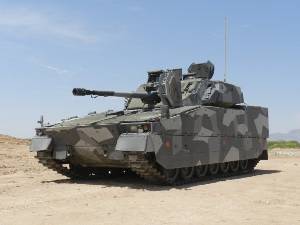
Last week, the U.S. Army began operational assessments of existing combat vehicles to validate capabilities against requirements for a new Infantry Fighting Vehicle. The effort, known as the Non-Developmental Vehicle, or NDV, Assessments will take place on the border of Fort Bliss, Texas, and White Sands Missile Range, N.M.
The assessments are being conducted on domestic vehicles - the M2A3 Bradley Fighting Vehicle, M1126 Stryker Infantry Carrier Vehicle Double V-Hull, and a Turretless Bradley - as well as the Israeli Namer and Swedish CV-9035, both international vehicles.
The NDVs included in the assessments feature a wide range of unique capabilities and attributes, which will allow the Army to conduct a comprehensive analysis of multiple configurations and families of vehicles to better understand requirements achievability.
Operational assessments are being conducted on each vehicle with focus on individual key characteristics. Each NDV encompasses unique technologies specific to individual country
requirements, enabling the Army's Project Manager for Ground Combat Vehicle to balance these requirements against mobility, survivability, growth and lethality capability gaps.
"We have a very good mix of vehicles with unique attributes and capabilities," said Col. Andrew DiMarco, the Army's project manager for Ground Combat Vehicle, or GCV. "Information gained from these operational assessments will contribute to the body of analysis the Army uses to validate existing capabilities against the requirements for a new GCV Infantry Fighting Vehicle, IFV, as well as further inform potential design trade-offs."
The NDV Assessment effort, directed in the Milestone A Acquisition Decision Memorandum on Aug. 17, 2011, is one part of the GCV program's three-pronged approach to the GCV IFV Technology Development, known as the TD phase, which is focused on reducing cost and schedule risk prior to Milestone B. The other two prongs in the approach use contractor developed, best-value design and a continued effort to analyze and model operational attributes and capabilities against cost, schedule and performance risks.
Conducting the NDV Assessments at Fort Bliss allows the Army to utilize an operationally relevant environment. These operational assessments will focus on field observations, Soldier surveys and interviews, and static exercises in varying conditions.
"Successfully developing, building and fielding a capable Infantry Fighting Vehicle that meets affordability and schedule demands depends on aggressive exploration of the capabilities trade-space and the full range of alternatives prior to finalizing requirements," said DiMarco.
Soldier-based operational insights gleamed from the NDV Assessment will be used to refine requirements in the GCV Capability Development Document and inform Army and Office of the
Secretary of Defense decision makers at the program's upcoming Milestone B.
The NDV Assessments will continue through May 25th.
US Army
24.05.2012